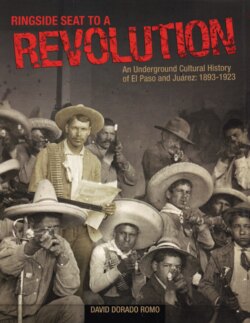Читать книгу Ringside Seat to a Revolution - David Dorado Romo - Страница 31
На сайте Литреса книга снята с продажи.
Оглавлениеthey “were unanimous in expressing their respect for
the high character of Miss Urrea, and their belief that
she is possessed of extraordinary healing powers.”30
Teresita soon became the most famous woman in
El Paso. Her name appeared regularly in the gossip
columns of the local newspapers. El Pasoans couldn’t
get enough of her. One postcard salesman did a
“hefty business” selling pictures of Teresita through-
out the area, as far as the neighboring town of Las
Cruces. It wasn’t just
“Mexican peons”—as the
Anglo press called them—
who gathered around
Teresita. The sick of all
races, the curious, the
insane, thieves, peddlers,
upper-class admirers, anti-
Díaz rebels, newspaper
reporters, law-enforcement
officers and paid govern-
ment informants from
both sides of the border,
all hovered around
Teresita’s Segundo Barrio
home. The newspapers
kept their readers
informed about every new
development. They pub-
lished regular dispatches
about her healings, her
dress, and about every
important guest who
stopped by to chat with
her—such as El Paso
Mayor Richard Campbell
or the ex-governor of
Chihuahua, Lauro Carrillo.
The El Paso Times reported on June 27, 1896—
only two weeks after Teresita’s arrival—that the for-
mer Chihuahuan governor brought a message from
president Porfirio Díaz for Teresita:
The message was an invitation to the young
lady and her father to visit Mexico and
remain as long as they wished…The presi-
dent would extend to them the protection of
the government and guarantee to them per-
fect liberty to go and come at will. It was the
wish of the president that the erroneous
impression should not go out that Santa
Teresa was expatriated from her native coun-
try. After consulting with her father, she told
the president’s messenger that she would
never set foot on Mexican soil so long as Mr.
Díaz was in power.
Reading about Teresita in the El Paso newspapers
was almost like watching a modern day soap opera,
except with an added dose of international political
intrigue. News of the young lady’s suitors immediate-
ly made the front pages. On November 19, 1896, the
El Paso Times informed its
readers that Dr. Apolonio
Rodríguez of Cuba had
asked for Teresita’s hand in
marriage. He was armed
with a letter of recommen-
dation from President Díaz
certifying the young physi-
cian’s “good moral character
and ability.” The El Paso
Times wrote:
Soon after his arrival
here the young doc-
tor began paying
court to Santa
Teresa. He wanted to
wed her. She had
taken his proposition
under advisement
with the promise to
give him an answer
in a few days. Dr.
Rodríguez said
Teresa at first refused
to listen to him, but
the doctor persuad-
ed the coy maiden to
listen to his wooing, and a wedding dress
was ordered...He believes that a matrimoni-
al alliance with the young lady would give
him an immense practice and at the same
time he admits that he admires the young
lady very much.”31
The next day, the El Paso Times published Teresita
Urrea’s disclaimer plus reports that many of her sup-
porters believed that Rodríguez was an agent of the
Mexican government who wanted to kidnap her back
to Mexico where she would be placed under arrest:
I have not said a word to that gentleman [Dr.
Apolonio Rodríguez] that would authorize
26
Teresita Urrea, ca. 1897.
(Southwest Collection, Texas Tech University.)
30
El Paso Herald, June 23, 1896.
31
El Paso Times, November 19, 1896.
